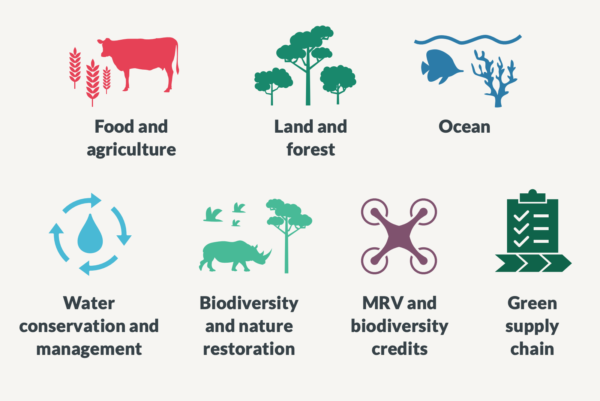Get ready to see more tech innovations that aim to protect, restore, measure and report on nature.
There is a palpable energy emerging for technologies that can be used to protect and restore nature, often called “nature tech.” The nascent market is primed for explosive growth in the coming years, following the establishment of the U.N.’s global biodiversity framework and growing pressure for financial and corporate disclosures on nature. According to one estimate, the nature tech market could exceed $6 billion by 2030 (and that was based on a narrow, outdated definition of what it includes).
Nature tech is evolving from a sector trying to distinguish itself from climate tech to one ready to stand on its own. Here are three signs.
‘Nature tech’ is its own investment category
According to the latest State of Nature Tech report from Nature4Climate, Nature Tech Collective and Serena, nature tech attracted $7.5 billion in venture capital in the last five years. Whereas climate tech focuses primarily on reducing greenhouse gas emissions and mitigating climate change, nature tech extends beyond climate to address environmental concerns more broadly, including species loss and habitat degradation. The full range of applications is shown in the figure below.

Source: The State of Nature Tech. Building Confidence in a Growing Market 2023.
However, last year nature tech still received just $1.6 billion in venture capital investment, compared to the $41 billion going toward climate tech startups. One of the greatest obstacles to attracting funding for nature is that it’s difficult to measure. There are no simple metrics equivalent to the ton of carbon that’s used in climate finance.
Nature Tech Collective, a non-profit network alliance with more than 100 member organizations, is working to close that nature data gap and garner more of the estimated $700 billion needed annually to protect and restore global ecosystems. Last week it changed its name from MRV Collective to underscore that focus shift.
Demand is growing
Corporations are scrambling to find the right data and tools, now that mandatory nature and biodiversity disclosures are on the horizon, such as the Corporate Sustainability Reporting Directive (CSRD) going into effect Jan. 1 and the EU Deforestation Regulation with a compliance deadline of December 2024. Gig Kaplan, co-founder of Wix.com and co-founder of Nature Tech Collective, says this has been a huge shift for nature tech companies.
One of the greatest obstacles to attracting funding for nature is that it’s difficult to measure. There are no simple metrics equivalent to the ton of carbon that’s used in climate finance.
“Until three or four years ago, people in this space had to convince buyers and investors that the [biodiversity] problem is real and to give them some money. Now companies are coming to us, asking for solutions that will scale,” Kaplan explained. Corporations with advanced nature strategies identify on-the-ground implementation as their most pressing challenge. Yet, nature tech companies selling on-the-ground solutions struggle to find customers willing to pay for these solutions.
To begin addressing this misalignment, Nature Tech Collective has developed two new strategies for corporations and financial institutions. Its “sector intelligence unit” will provide comprehensive sector maps and directories of vetted solutions to solve specific challenges. A company looking to, say, reduce its impact on mangroves can go to a one-stop shop to understand the jobs to be done and a tech stack for protecting and restoring mangroves.
Its “acceleration unit” will offer a six-month mentorship program including technical support to help a company solve a specific nature-related challenge. The process will look different depending on the company’s level of resources and needs. If a food and agriculture company is looking to reduce methane emissions from beef production, the collective might pair it with vetted nature tech companies or NGOs, or an innovation competition such as the Con X Tech Prize to create something new.
Technology is only part of the answer
While I’m excited to see nature tech start to emerge, I’m also grateful there is recognition that technology alone won’t solve the biodiversity crisis.
The State of Nature Tech report emphasizes the sector must consider social outcomes to produce a sustainable future, and includes the following pointers:
- Test new technologies in-field before deploying them at scale
- Aim for gender, racial and ethnic diversity in development teams
- Involve local communities and indigenous people (as is their right) in design and deployment
- Make affordable and accessible technologies
- Make data transparent and secure
This article originally appeared on GreenBiz.com as part of our partnership with GreenBiz Group, a media and events company that accelerates the just transition to a clean economy.


